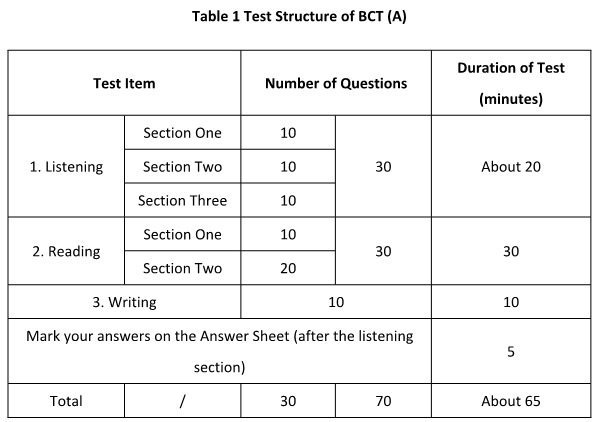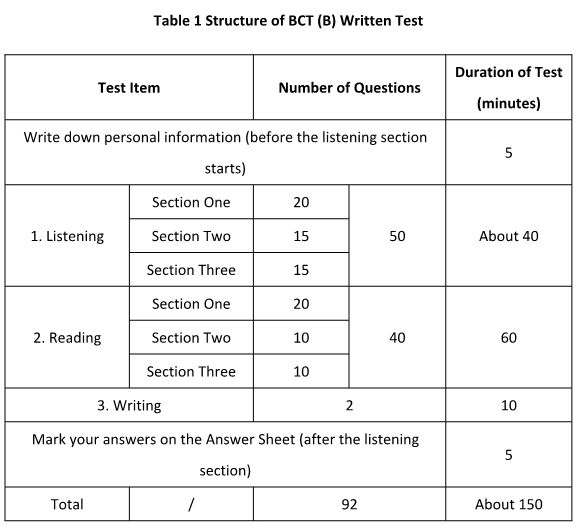Business Chinese Test(BCT)

To meet Chinese language learners’ need for a business Chinese test,the Confucius Institute Headquarters (Hanban) commissioned the International Business Chinese Language Teaching and Resource Development Base, University of International Business and Economics to organize Chinese and overseas experts on business Chinese language teaching, linguistics, psychology and educational measurement to revise the Business Chinese Test (BCT) which has existed since 2006 on the basis of the latest research results on international language testing and business Chinese from recent years.
The new BCT, as an international,standardized test of Chinese language proficiency, focuses on assessing non-native Chinese speakers’ abilities to use the Chinese language in real business or common working environments and evaluating the language tasks they are able to complete. It aims to provide references for companies to recruit and select employees, for schools and training institutions to organize teaching activities, and for learners to evaluate themselves.
The BCT, as a test series, consists of three independent tests: BCT (A), BCT (B) and the BCT Speaking Test. The BCT (A), which is oriented towards beginners, is designed to examine test takers’ ability to communicate in Chinese in daily life and during basic business activities. The BCT (B),which is oriented towards intermediate and advanced learners, is designed to examine test takers’ ability to communicate in Chinese during complex business activities. The BCT Speaking Test, which is oriented towards learners of all levels, adopts the form of a computer-based test as well as personalized and targeted questions to examine test takers’ ability to complete various communicative tasks by using spoken Chinese.
The BCT has the following characteristics: first, it focuses on the practical use of Chinese when conducting business activities. The test, following the principle of practicality, oriented towards speaking and listening, and emphasizing abilities in the workplace, aims to recreate actual situations in the workplace. Second, it has set the Standards for Business Chinese Language Competence and advocates a combination of teaching and examination as a method of improving Chinese language skills. The Standards for Business Chinese Language Competence, which is based on large-scale surveys and data analyses and aligned with the BCT Outlines, provides a basis for a refined assessment of competence and systematic teaching activities. Third, it includes business culture as a part of the test so as to improve learners’ intercultural communicative competence.
Test Takers
The BCT is held for non-native Chinese speakers. Anyone who is a non-native speaker, whether capable of basic communication or fairly skillful communication in Chinese, may take the BCT. There are no restrictions on test takers’ age, education or length of time spent learning Chinese.
Test Time and Location
The BCT is held regularly in mainland China and other countries each year. In addition, BCT can provide special testing services as required by relevant enterprises or organizations.
For information about the test dates and test centers for the BCT, please log on to the Chinese test service website www.chinesetest.cn.
Test Purposes
1.Provide a basis for employers to assess non-native Chinese speakers’ (candidates) Chinese competence in daily work. Test scores can be used as a reference for employee recruitment, selection, placement and promotion.
2.Help relevant teaching and training institutions to assess students’ business Chinese proficiency in recruitment, class divisions, and granting credits.
3.Help learners to improve and evaluate their business Chinese competence.
BCT (A)
The BCT (A) is an international, standardized exam in Chinese language proficiency that focuses on testing non-native Chinese speakers' abilities to use the Chinese language in real business or common working environments, and that evaluates the language tasks they are able to complete. Following the principle of practicality, oriented towards speaking and listening, and emphasizing abilities in the workplace, this test aims to recreate actual situations in the workplace and takes practical content for communications as the method of examining test takers’ abilities to use Chinese to meet their needs in a working environment.
I. Test Structure
BCT (A) contains 70 question sand consists of three parts: listening, reading and writing.

The duration of the whole test is about 150 minutes (including 5 minutes for writing down personal information).
1. Listening
Section One contains twenty questions. A two-sentence dialogue between two people and a question based on the dialogue will be read once for each question. Choose the best answer from the four choices on the test paper according to what you hear.
Section Two contains fifteen questions. A four-sentence dialogue between two people and a question based on the dialogue will be read once for each question. Choose the best answer from the four choices on the test paper according to what you hear.
Section Three contains fifteen questions. Five passages followed bya few questions will be read to you once. Choose the best answer from the choices on the test paper according to what you hear.
2. Reading
Section One contains twenty questions. A series of reading materials will be provided, including pictures, tables, paragraphs, passages, etc. Each piece of reading material will be followed by a few questions, each with four choices. Choose the best answer to the question.
Section Two contains ten questions. There are two passages with five blanks each. Choose five best answers from seven choices to complete each passage according to the context.
Section Three contains ten questions. This section is divided into two groups, each with five questions. Four passages and several questions or sentences will be provided on the test paper. Match each question or sentence with its related passage.
3. Writing
Section One contains one question. A written text or table will be provided. Write at least 80 Chinese characters according to the directions.
Section Two contains one question. A written text or table will be provided. Write at least 150 Chinese characters according to the directions.
II. Reference Vocabulary
The BCT (B) has set up a reference vocabulary of 4000 words according to language competence, can-do statements, word frequencies of various authoritative Chinese corpora, and the state of international Chinese language teaching.
III. Score System
The BCT (B) score report records a test taker's sub-test scores and total score, without setting any passing score. The report will also provide competence descriptions for all levels of test takers.
The BCT (B) written test consists of three sub-tests: listening, reading and writing, with a total score of 300 points. Its score system is shown in the table below:

IV. Test Principles
Promote learning through examination: encourage Chinese language learners' interest and confidence, and further broaden the scope of the test in accordance with the actual demands of overseas Business Chinese learners and Chinese speakers in a general working environment.
Promote teaching through examination: provide teachers and self-learners with graded, task-based teaching resource sand suggestions related to business Chinese, and help teaching and training institutions systematically and effectively improve business Chinese learners and speakers' abilities to use the Chinese language in real business or common working environments.
Provide positive feedback for test takers: evaluate test takers' ability to complete various language tasks by asking them to carry out a series of typical business language tasks and provide positive feedback for Chinese language learners to plan their future studies.
BCT (B)
The BCT (B) is an international, standardized exam in Chinese language proficiency that focuses on testing non-native Chinese speakers' abilities to use the Chinese language in real business or common working environments, and that evaluates the language tasks they are able to complete. Following the principle of practicality, oriented towards speaking and listening, and emphasizing abilities in the workplace, this test aims to recreate actual situations in the workplace and takes practical content for communications as the method of examining test takers’ abilities to use Chinese to meet their needs in the working environment.
I. Test Structure
The BCT (B) written test contains 92 question sand consists of three parts: listening, reading and writing.

The duration of the whole test is about 150 minutes (including 5 minutes for writing down personal information).
1. Listening
Section One contains twenty questions. A two-sentence dialogue between two people and a question based on the dialogue will be read once for each question. Choose the best answer from the four choices on the test paper according to what you hear.
Section Two contains fifteen questions. A four-sentence dialogue between two people and a question based on the dialogue will be read once for each question. Choose the best answer from the four choices on the test paper according to what you hear.
Section Three contains fifteen questions. Five passages followed bya few questions will be read to you once. Choose the best answer from the choices on the test paper according to what you hear.
2. Reading
Section One contains twenty questions. A series of reading materials will be provided, including pictures, tables, paragraphs, passages, etc. Each piece of reading material will be followed by a few questions, each with four choices. Choose the best answer to the question.
Section Two contains ten questions. There are two passages with five blanks each. Choose five best answers from seven choices to complete each passage according to the context.
Section Three contains ten questions. This section is divided into two groups, each with five questions. Four passages and several questions or sentences will be provided on the test paper. Match each question or sentence with its related passage.
3. Writing
Section One contains one question. A written text or table will be provided. Write at least 80 Chinese characters according to the directions.
Section Two contains one question. A written text or table will be provided. Write at least 150 Chinese characters according to the directions.
II. Reference Vocabulary
The BCT (B) has set up a reference vocabulary of 4000 words according to language competence, can-do statements, word frequencies of various authoritative Chinese corpora, and the state of international Chinese language teaching.
III. Score System
The BCT (B) score report records a test taker's sub-test scores and total score, without setting any passing score. The report will also provide competence descriptions for all levels of test takers.
The BCT (B) written test consists of three sub-tests: listening, reading and writing, with a total score of 300 points. Its score system is shown in the table below:

IV. Test Principles
Promote learning through examination: encourage Chinese language learners' interest and confidence, and further broaden the scope of the test in accordance with the actual demands of overseas Business Chinese learners and Chinese speakers in a general working environment.
Promote teaching through examination: provide teachers and self-learners with graded, task-based teaching resource sand suggestions related to business Chinese, and help teaching and training institutions systematically and effectively improve business Chinese learners and speakers' Chinese language communicative competence in a realistic business environment.
Provide positive feedback: evaluate test takers' ability to complete various language tasks in a business environment by asking them to carry out a series of typical business language tasks and provide positive feedback for Chinese language learners to plan their future studies.
MOST POPULAR
- 1 China to continue opening up its mega-market to world: premier
- 2 Policies concerning expats, foreign enterprises in November 2025
- 3 China to enhance convenience for inbound tourism: minister
- 4 Departure tax refund applications surge 285% as inbound tourism rebounds
- 5 China's foreign trade up 3.6% in first 11 months of 2025







